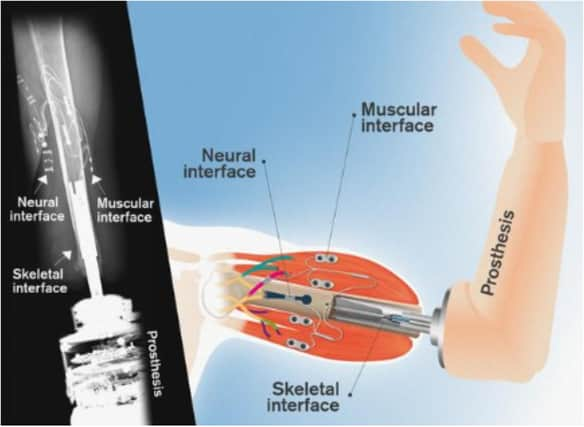Self-contained bionic arm controlled by mind ‘could be available in two years’


An implant system that allows users to control their bionic arm with their thoughts without the need for any supporting equipment could be available in Europe in the next two years, scientists have said.
The researchers in Sweden who designed the system are hoping to get a CE mark for their product so it complies with the EU's safety and health protection requirements.
Advertisement
Hide AdAdvertisement
Hide AdThe implant system, which can connect to any commercially available arm prosthesis, is currently being used by three people in Sweden who have had an amputation above the elbow.
Dr Max Ortiz Catalan, an associate professor at Chalmers University of Technology in Sweden, said that their prosthesis could be a clinically viable replacement for a lost arm.
He told the PA news agency: "People in Sweden can have this technology now.
"We were working to ramp up the production before the pandemic began.
"We are aiming to have it CE marked soon, within two years, and once it is CE marked, it can be available in Europe as a product."
Two of the three patients involved in their clinical trial have been using their bionic arms for around three years, while the third participant has been using his artificial limb for seven years.
A new functionality - the sensation of touch - has recently been added to all the three prosthetic arms.
Dr Ortiz Catalan said that the implant system, which anchors the prosthesis to the skeleton in the stump of the amputated limb, is stable and can be used for long periods of time without any intervention from the scientists.
Advertisement
Hide AdAdvertisement
Hide AdHe told PA: "The real breakthrough here is that this neuromusculoskeletal interface, as we call it, allows the artificial limb to be connected to the body.
"And when you have that intimate connection between the technology and biology, you can have a better control and establish sensory feedback."
According to Dr Ortiz Catalan, the system delivers sensations that feel like they are arising from the missing hand.
The implant system is self-contained, so patients do not need to carry additional equipment such as large computer backpacks or batteries.
Electrodes fixed in the remaining muscle in the stump deliver sensory information, which allows users to have greater sensation and control over the hand.
Patients are able to feel when they are touching an object, its characteristics, and how hard they are pressing it, the researchers said.
Dr Ortiz Catalan said while the prosthetic is not as good as real hand it does allow people to be able to go about their daily lives.
He added: "We are not under the illusion that this technology is perfect - there is still long way to go.
Advertisement
Hide AdAdvertisement
Hide Ad"In the meantime, we are looking to increase functionality by adding more sensations and more control."
The research is published in the New England Journal of Medicine.
A message from the Editor:
Thank you for reading this story on our website. While I have your attention, I also have an important request to make of you.
With the coronavirus lockdown having a major impact on many of our advertisers - and consequently the revenue we receive - we are more reliant than ever on you taking out a digital subscription.
Subscribe to scotsman.com and enjoy unlimited access to Scottish news and information online and on our app. With a digital subscription, you can read more than 5 articles, see fewer ads, enjoy faster load times, and get access to exclusive newsletters and content. Visit https://www.scotsman.com/subscriptions now to sign up.
Our journalism costs money and we rely on advertising, print and digital revenues to help to support them. By supporting us, we are able to support you in providing trusted, fact-checked content for this website
Comments
Want to join the conversation? Please or to comment on this article.